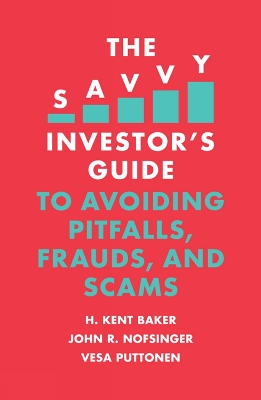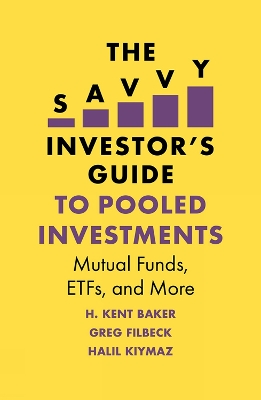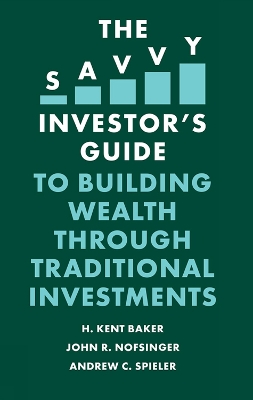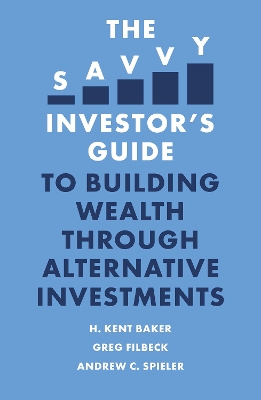The Savvy Investor's Guide
4 total works
The Savvy Investor's Guide to Avoiding Pitfalls, Frauds, and Scams
by H. Kent Baker, John R. Nofsinger, and Vesa Puttonen
Published 21 January 2020
Are you an investor facing an obstacle you don’t know how to overcome?
Are you ready to invest, but not sure how to reduce your risks?
There are two important things you must do to be a savvy investor: make good investment decisions and avoid costly mistakes. As important as good investments are, one bad mistake can ruin the result of all your good decisions. In the second book in The H. Kent Baker Investments Series, investing experts H. Kent Baker, John R. Nofsinger, and Vesa Puttonen offer an insightful guide on avoiding those detrimental missteps.
The Savvy Investor's Guide to Avoiding Pitfalls, Frauds and Scams explores the common pitfalls that investors face. Highlighting important issues when investing especially in common stocks and mutual funds, they explore the psychological biases of investors that can cause you to be your own worst enemy. Finally, they look at frauds and scams, and how to protect yourself from dishonest people wanting to profit at your expense.
If you feel unprepared to face the risks of investing, Baker, Nofsinger, and Puttonen provide this essential guide to arming yourself against devastation on your path to becoming a savvy investor.
Are you ready to invest, but not sure how to reduce your risks?
There are two important things you must do to be a savvy investor: make good investment decisions and avoid costly mistakes. As important as good investments are, one bad mistake can ruin the result of all your good decisions. In the second book in The H. Kent Baker Investments Series, investing experts H. Kent Baker, John R. Nofsinger, and Vesa Puttonen offer an insightful guide on avoiding those detrimental missteps.
The Savvy Investor's Guide to Avoiding Pitfalls, Frauds and Scams explores the common pitfalls that investors face. Highlighting important issues when investing especially in common stocks and mutual funds, they explore the psychological biases of investors that can cause you to be your own worst enemy. Finally, they look at frauds and scams, and how to protect yourself from dishonest people wanting to profit at your expense.
If you feel unprepared to face the risks of investing, Baker, Nofsinger, and Puttonen provide this essential guide to arming yourself against devastation on your path to becoming a savvy investor.
The Savvy Investor's Guide to Pooled Investments
by H. Kent Baker, Greg Filbeck, and Halil Kiymaz
Published 28 February 2019
Do you only have a relatively small amount of money to invest? Do you think this limitation give you only a few investment choices?
Well, it doesn’t.
Investing experts H. Kent Baker, Greg Filbeck, and Halil Kiymaz offer an essential guide to one of the most common ways to invest: a pooled investment vehicle (PIV). A PIV is an investment fund that commingles the monies of many different investors to buy a portfolio that reflects a particular investment objective. – By using PIVs, you gain a diversified portfolio, which once was only available to large investors.
The Savvy Investor’s Guide to Pooled Investments clearly explains the risks and advantages of investing in a PIV. This book introduces you to five PIVs – mutual funds, exchange-traded funds (ETFs), closed-end funds (CEFs), unit investment trusts (UITs), and real estate investment trusts (REITs) – with a unique Q&A format employed to delve into issues that investors want and need to know before choosing a PIV.
If you have ever felt limited by your investment choices, Baker, Filbeck, and Kiymaz explain your options to creating an investment portfolio, which is an initial step to becoming a savvy investor.
Well, it doesn’t.
Investing experts H. Kent Baker, Greg Filbeck, and Halil Kiymaz offer an essential guide to one of the most common ways to invest: a pooled investment vehicle (PIV). A PIV is an investment fund that commingles the monies of many different investors to buy a portfolio that reflects a particular investment objective. – By using PIVs, you gain a diversified portfolio, which once was only available to large investors.
The Savvy Investor’s Guide to Pooled Investments clearly explains the risks and advantages of investing in a PIV. This book introduces you to five PIVs – mutual funds, exchange-traded funds (ETFs), closed-end funds (CEFs), unit investment trusts (UITs), and real estate investment trusts (REITs) – with a unique Q&A format employed to delve into issues that investors want and need to know before choosing a PIV.
If you have ever felt limited by your investment choices, Baker, Filbeck, and Kiymaz explain your options to creating an investment portfolio, which is an initial step to becoming a savvy investor.
The Savvy Investor's Guide to Building Wealth Through Traditional Investments
by H. Kent Baker, John R. Nofsinger, and Andrew C. Spieler
Published 16 April 2020
Would you like to be a millionaire?
If you're like most people, your answer is "yes". But unlike popular opinion, this goal is not beyond your reach. Building wealth is more common sense than secret formula. You need to invest wisely.
This easy-to-read guide focuses on traditional investments - stocks, bonds, and cash or cash equivalents. Stocks and bonds are the heartbeat of Wall Street. Finance experts H. Kent Baker, John R. Nofsinger, and Andrew C. Spieler take you through how to invest in a single security, as well as mutual funds and exchange-traded funds (ETFs), which offer many potential benefits to individual investors.
This practical and straightforward book is written for novice investors. It takes an innovative question-and-answer format to help you learn about traditional investments and to become a better investor. If you want to become a millionaire, and don't have the luck of buying a winning lottery ticket, this guide is for you.
If you're like most people, your answer is "yes". But unlike popular opinion, this goal is not beyond your reach. Building wealth is more common sense than secret formula. You need to invest wisely.
This easy-to-read guide focuses on traditional investments - stocks, bonds, and cash or cash equivalents. Stocks and bonds are the heartbeat of Wall Street. Finance experts H. Kent Baker, John R. Nofsinger, and Andrew C. Spieler take you through how to invest in a single security, as well as mutual funds and exchange-traded funds (ETFs), which offer many potential benefits to individual investors.
This practical and straightforward book is written for novice investors. It takes an innovative question-and-answer format to help you learn about traditional investments and to become a better investor. If you want to become a millionaire, and don't have the luck of buying a winning lottery ticket, this guide is for you.
The Savvy Investor’s Guide to Building Wealth Through Alternative Investments
by H. Kent Baker, Greg Filbeck, and Andrew C. Spieler
Published 13 July 2021
Do you want to see your wealth grow?
If so, then this easy-to-read guide that focuses on alternative investments - hedge funds, private equity, real estate, commodities, and infrastructure - is just for you.
The fourth book in The H. Kent Baker Investments Series attempts to remove some of the mystery surrounding these investments so that you can determine whether any of these are right for you. If you're willing to gain the necessary knowledge, you may be able to build long-term wealth by taking advantage of the benefits that each investment has to offer.
The Savvy Investor's Guide to Building Wealth Through Alternative Investments is written for investors familiar with traditional investments but with limited knowledge of alternative assets and strategies.
If so, then this easy-to-read guide that focuses on alternative investments - hedge funds, private equity, real estate, commodities, and infrastructure - is just for you.
The fourth book in The H. Kent Baker Investments Series attempts to remove some of the mystery surrounding these investments so that you can determine whether any of these are right for you. If you're willing to gain the necessary knowledge, you may be able to build long-term wealth by taking advantage of the benefits that each investment has to offer.
The Savvy Investor's Guide to Building Wealth Through Alternative Investments is written for investors familiar with traditional investments but with limited knowledge of alternative assets and strategies.



